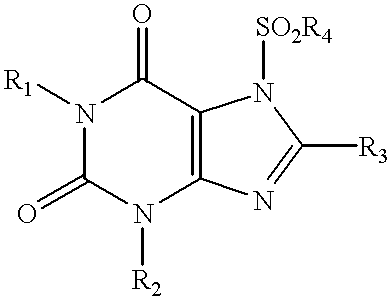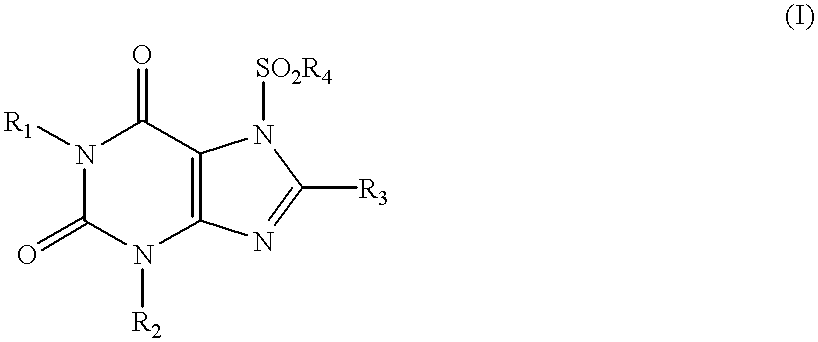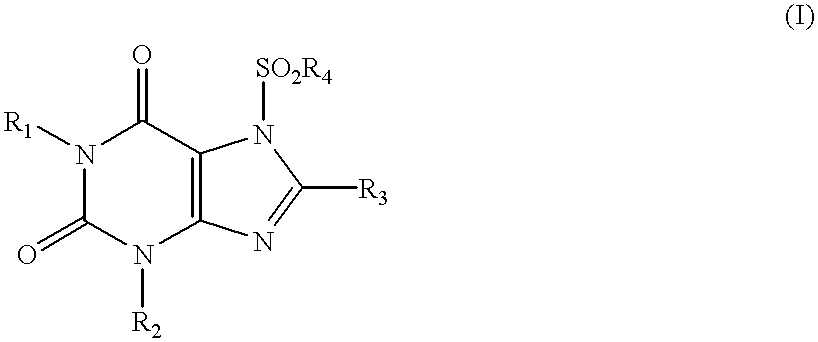Method of treating bone loss by stimulation of calcitonin
a technology of calcitonin and bone loss, which is applied in the direction of biocide, drug composition, metabolic disorder, etc., can solve the problem of lack of oral bioavailability in the wide-spread use o
- Summary
- Abstract
- Description
- Claims
- Application Information
AI Technical Summary
Problems solved by technology
Method used
Image
Examples
examples
The plasma calcitonin elevation activity of the compounds of this invention was established in accordance with standard pharmaceutically accepted test procedures with representative compounds as follows:
example a
Calcitonin / Luciferase Reporter Gene Expression Assay
This assay was used to determine the ability of a compound to stimulate transcription of a luciferase reporter gene regulated by 3 kb of the promoter region of the human calcitonin gene.
A reporter cell line (designated C.sub.1-3) was developed by Oncogene Science by stable transfection of a single, unrearranged copy of a calcitonin / luciferase reporter gene construct into the TT human thyroid carcinoma cell line as described in U.S. Pat. No. 5,665,543. C.sub.1-3 cells were plated at a density of 6,500-7,500 cells per well in a 96-plate microtiter plate. Twenty-four to forty-eight hours later, compounds were added to the wells in triplicate. Compounds were tested at a concentration of 10 .mu.g / mL in 0.5% DMSO. Compounds that exhibited a transcription activation ratio (TAR)>1.5 (equivalent to >50% increase in transcription) advanced to primary follow-up (CA-FUP), in which compounds were re-screened at four concentrations: 10 .mu.g / mL,...
example b
Calcitonin Secretion / RIA Assay Protocol
This assay was used to determine the ability of a compound to increase the amount of calcitonin secreted by the C.sub.1-3 cell line.
A calcitonin RIA kit (Nichols Institute Diagnostics, Kit# 40-2125) was used in accordance with manufacturer's suggestions as summarized below:
Materials:
Cell Line: C.sub.1-3 (Parent Cell Line: TT-medullary thyroid carcinoma),
Reagents:
Reagent A - (Anti-Calcitonin)
Reagent B - (.sup.125 I-Calcitonin)
Regent C - (Anti-Goat Precipitant)
Regent D - (Zero Standard).
Reagents E-I - (Calcitonin Standards)
Reagents J-K (Calcitonin Controls: Level and Level 2)
Reagent L - (NSB Buffer)
Procedure:
1. Glass tubes were labeled to include Total Count (TC), Nonspecific Binding (NSB), Maximum Binding (Bo), Standards, Controls and Patient Sera in duplicate.
2. 300 mL of Standard Zero (Reagent D) was added to tubes 3 through 6 (NSB and Bo).
3. 300 mL of Standards* (Reagents E-1) was added to tubes 7-16 as follows:
4. 300 mL of Patient Serum 1 wa...
PUM
| Property | Measurement | Unit |
|---|---|---|
| concentrations | aaaaa | aaaaa |
| concentrations | aaaaa | aaaaa |
| concentrations | aaaaa | aaaaa |
Abstract
Description
Claims
Application Information
 Login to View More
Login to View More - R&D
- Intellectual Property
- Life Sciences
- Materials
- Tech Scout
- Unparalleled Data Quality
- Higher Quality Content
- 60% Fewer Hallucinations
Browse by: Latest US Patents, China's latest patents, Technical Efficacy Thesaurus, Application Domain, Technology Topic, Popular Technical Reports.
© 2025 PatSnap. All rights reserved.Legal|Privacy policy|Modern Slavery Act Transparency Statement|Sitemap|About US| Contact US: help@patsnap.com



